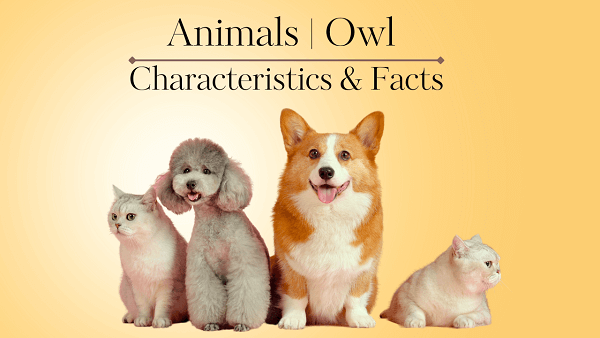
Owl Definition | Characteristics & Facts
Owl Definition
An owl is a nocturnal bird of prey characterized by its round face, large eyes, sharp talons, and distinct hooting sound. Owls are known for their exceptional night vision and silent flight, making them efficient hunters.
General Characteristics & Facts Owl
Owl Classification
Owls belong to the order Strigiformes, which includes around 200 species. They are further classified into two families: Tytonidae (barn owls) and Strigidae (typical owls).
Size and Appearance
Owls vary in size, with the smallest species, like the Elf Owl, measuring around 5 inches (13 cm) tall, and the largest species, like the Blakiston's fish owl, reaching up to 30 inches (75 cm) tall. They have a distinctive round facial disk, large forward-facing eyes, and a sharp, hooked beak.
Nocturnal Adaptations
Owls are primarily nocturnal, meaning they are active during the night. Their eyes are specially adapted for low-light conditions, with a high number of rod cells, allowing them to see in the dark.
Habitat and Distribution
Owls are found on every continent except Antarctica. They occupy diverse habitats such as forests, grasslands, deserts, tundra, and even urban areas. Different owl species have specific habitat preferences, ranging from dense forests to open fields.
Diet and Feeding
Owls are carnivorous and predominantly feed on small mammals such as rodents, rabbits, and bats. However, their diet can also include birds, reptiles, amphibians, and invertebrates. Owls have excellent hunting skills and use their sharp talons and beaks to catch and kill their prey.
Life Cycle
Owls typically mate for life. They have different courtship rituals that involve vocalizations, displays, and gifts of prey. Females lay eggs in a nest, usually located in a tree cavity, abandoned nest, or on a cliff ledge. The incubation period varies between species but generally lasts around 30-40 days. Owlets hatch and are cared for by both parents until they can fly and hunt on their own.
Adaptations and Survival
Owls have various adaptations that aid in their survival. Their feathers have specialized fringes that reduce turbulence and noise during flight. Owl wings also have soft edges that enable them to fly silently. Additionally, their feathers provide excellent insulation, keeping them warm in cold weather.
Symbolism and Folklore
Owls have been depicted in various cultures and mythologies throughout history. They are often associated with wisdom, intuition, and mystery. In some cultures, they are seen as symbols of protection, while in others, they are considered omens of bad luck.
Threats and Conservation
Owls face several threats, including habitat loss, deforestation, pesticide use, and collisions with vehicles. Some species are also hunted or trapped for their feathers, body parts, or due to superstitions.
Owl Physical Characteristics
- Wings: Owls have large wings, designed for silent flight. Their wings are broad and rounded, allowing them to glide through the air with minimal noise.
- Facial Disk: Owls have a unique facial disk, which consists of feathers arranged in a circular pattern around their eyes. This disk helps to funnel sound toward their ears, improving their hearing abilities.
- Large Eyes: Owls have large, forward-facing eyes that are adapted for excellent low-light vision. Their eyes are fixed in their sockets, so they must turn their entire head to change their field of view.
- Beak: Owls have a hooked beak that is curved and sharp. The shape of their beak aids in tearing and consuming their prey.
- Plumage: Owls have soft feathers that allow for silent flight. Their plumage is typically mottled or camouflaged, helping them blend into their surroundings.
- Talons: Owls possess strong, sharp talons on their feet that are used for capturing and grasping their prey. They have a powerful grip, enabling them to capture and hold onto their prey securely.
- Head Rotation: Owls have the ability to rotate their heads up to 270 degrees, thanks to their flexible neck joints. This unique adaptation allows them to scan their surroundings without moving their body.
- Size: Owl sizes can vary significantly depending on the species. They range from small owls, such as the Elf Owl, which measures around 5 inches (13 centimeters) in height, to large owls, such as the Eurasian Eagle-Owl, which can have a wingspan of over 6 feet (1.8 meters).
Continue To Explore All Animals That Start With O
Scientific Classification of Owl
Kingdom: Animalia
Phylum: Chordata
Class: Aves
Order: Strigiformes
Key Locations Of Owl
- United States
- Canada
- United Kingdom
- Germany
- France
- Russia
- China
- Japan
- Australia
- Brazil
View All A-Z Animals List
Owl FAQs
How many species of owls are there?
There are approximately 250 known species of owls worldwide. These species vary in size, appearance, behavior, and habitat preferences.
What do owls eat?
Owls are carnivorous and primarily feed on small mammals, such as mice, voles, and rabbits. They also consume birds, reptiles, amphibians, insects, and occasionally fish.
Can owls see in the dark?
Owls have excellent night vision and are adapted to see in low-light conditions. Their large eyes and specialized retina allow them to gather and process more light, aiding their vision in the dark.
Do all owls hoot?
No, not all owls hoot. While hooting is a common vocalization among many owl species, different owls produce a variety of sounds, including screeches, whistles, hisses, and even trills.
How do owls fly silently?
Owls possess specialized feathers that reduce turbulence and noise during flight. These feathers have soft edges and a velvety texture that helps to muffle sound, enabling owls to fly silently and approach their prey undetected.




